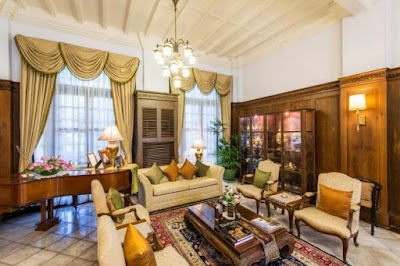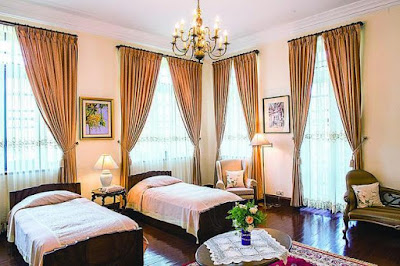The colonial-style residence of the Thai ambassador to Myanmar is recognized by the Association of Siamese Architects with a Historical and Architectural Conservation Award.
IT'S HARD to visit Yangon without succumbing to the allure of the city's
majestic colonial-era buildings. A team of Thai architects visited
Yangon last year on a mission to search for the remains of Ayutthaya's
King Uthumbhorn in Myanmar, and returned to Thailand not with a Siamese
artefact, but a Tudor inspiration.
Of all the beautiful colonial-style buildings they came across in Yangon, the one they admired the most was the residence of the Thai ambassador, describing it as the epitome of architectural conservation.
On their return, these same architects nominated the Thai residence to the Association of Siamese Architects for the prestigious Historical and Architectural Conservation Award. And in May, the association officially announced the residence as the winner.
The awards presentation was held recently and presided over by Her Royal Highness Princess Maha Chakri Sirindhorn, with Norachit Sinhaseni, Permanent Secretary for Foreign Affairs, receiving the award on the behalf of the Ministry of Foreign Affairs.
Of all the beautiful colonial-style buildings they came across in Yangon, the one they admired the most was the residence of the Thai ambassador, describing it as the epitome of architectural conservation.
On their return, these same architects nominated the Thai residence to the Association of Siamese Architects for the prestigious Historical and Architectural Conservation Award. And in May, the association officially announced the residence as the winner.
The awards presentation was held recently and presided over by Her Royal Highness Princess Maha Chakri Sirindhorn, with Norachit Sinhaseni, Permanent Secretary for Foreign Affairs, receiving the award on the behalf of the Ministry of Foreign Affairs.
It was the first time the association had recognised a heritage building
outside of Thailand and marked a turning point in the history of the
conservation award, says Dr Vasu Poshyanandana, one of the
vice-presidents of the ASA and a member of the judging committee.
He says the ASA picked the building for the award because of its architectural and historical value.
"Members of the judging panel were actually in Yangon on a completely different mission. While there, they were invited for dinner at the residence and discovered the beauty of the place. They found the building was quite old and well taken care of. On their return, they nominated the building to the association," Dr Vasu says.
The Tudor-style building that was to become the Thai ambassador's residence was originally owned by EM De Souza, a Portuguese-English businessman who purchased this house in 1902. Souza was a renowned importer of medicine during the colonial period where he operated a pharmacy at the De Souza building on Mahabanddoola Road just west of the Sule Pagoda.
The Thai government purchased this property as the residence of the Thai ambassador in 1948 when diplomatic relations between Myanmar and Thailand were established.
He says the ASA picked the building for the award because of its architectural and historical value.
"Members of the judging panel were actually in Yangon on a completely different mission. While there, they were invited for dinner at the residence and discovered the beauty of the place. They found the building was quite old and well taken care of. On their return, they nominated the building to the association," Dr Vasu says.
The Tudor-style building that was to become the Thai ambassador's residence was originally owned by EM De Souza, a Portuguese-English businessman who purchased this house in 1902. Souza was a renowned importer of medicine during the colonial period where he operated a pharmacy at the De Souza building on Mahabanddoola Road just west of the Sule Pagoda.
The Thai government purchased this property as the residence of the Thai ambassador in 1948 when diplomatic relations between Myanmar and Thailand were established.
Ambassador Pisanu Suvanajata was delighted with the award, saying the
embassy took great pride and honour in the recognition of the
stewardship of all former ambassadors and their families, as well as
embassy officials, in the conservation of this national and cultural
heritage.
The Thai residence not only serves as the property of the Royal Thai
government, but it has also hosted many stately events, most importantly
the royal banquet hosted by Their Majesties King Bhumibol and Queen
Sirikit for U Win Maung, the then President of Burma, in March 1960
during the royal couple's first and only state visit to Myanmar.
This residence had also hosted great number of VVIPs, leaders,
statesmen, and various historic events throughout the modern history of
Thai-Myanmar diplomatic relations.
Dr Vasu says he is sure that the residence invokes a certain nostalgia for life under British rule.
"Not all old buildings have value. But the century-old Thai residence
has high architectural and historical value. There are many buildings
like this in Yangon that were built when the country was still under
British rule. The style is British colonial, but there are no Myanmar
elements in the style at all. The residence is a half-timber building
that was adjusted in terms of styling to suit the country's climate.
"When I see it, it brings back memories of a certain period when this
form of architecture was flourishing. To me this building is a romantic
representation of the glorious past. It makes me think of life, people
and events during the colonial period, the way they lived their lives,"
he says.
Old buildings like the Thai residence need conservation in the face of
rampant urban development in both Thailand and its neighbouring
countries.
Quite a few of Myanmar's heritage buildings in Yangon are particularly
at risk of demolition as a result of modern development projects. But Dr
Vasu is glad that the Myanmar government and private conservation
projects have been able to protect many colonial buildings through
"adaptive use" approaches.
"Unlike Thailand, Myanmar has far more colonial buildings that still
stand to this day. They were built by the government. In our country,
many colonial-style buildings were built by the elite. Just look at the
palaces," he says.
He laments the fact that conservation is a foreign concept to the Thais
but hopes that this award will help inspire more conservation efforts.
"Conservation is not part of our nature and culture. It's an idea
imported from the West. To some people, conservation is about
demolishing an old building and replacing it with a new one. In the
past, we demolished and rebuilt religious structures, but then most of
our monks were blue-blooded aristocrats who had architectural knowledge
and taste.
"That's why buildings that were constructed during the Fifth Reign
still look amazing. But these days anyone can join the monkhood and they
may have neither knowledge nor taste. That's why some monks see
historic buildings as old and unwanted," he says, referring to a
controversy involving the abbot of Wat Kalayanamitr who replaced a
century-old building in the temple grounds with a new and ugly one.
He also laments that some of the notable buildings awarded by the ASA
such as the Supreme Court building near Sanam Luang have been torn down.
"With the Thai residence winning the conservation award, the ASA might
need to reset the award's criteria to make it more accommodating to
overseas nominations. That way other Thai embassies can nominate some of
their majestic old buildings," he says.
Source: The Nation
Source: The Nation
*****
For the Best #Hotels and #Resorts
We help you with your #Bookings
BOOK NOW SIMPLE CLICK ON THIS LINK ON OR THE BANNER
http://gerrit-tienkamp.blogspot.com/
http://planet-asian.blogspot.com/
https://asiabesthotels.wordpress.com/
https://europeanbesthotels.wordpress.com/
http://www.tripadvisor.com/members/Gerrit_Tienkamp
We help you with your #Bookings
BOOK NOW SIMPLE CLICK ON THIS LINK ON OR THE BANNER
http://gerrit-tienkamp.blogspot.com/
http://planet-asian.blogspot.com/
https://asiabesthotels.wordpress.com/
https://europeanbesthotels.wordpress.com/
http://www.tripadvisor.com/members/Gerrit_Tienkamp





